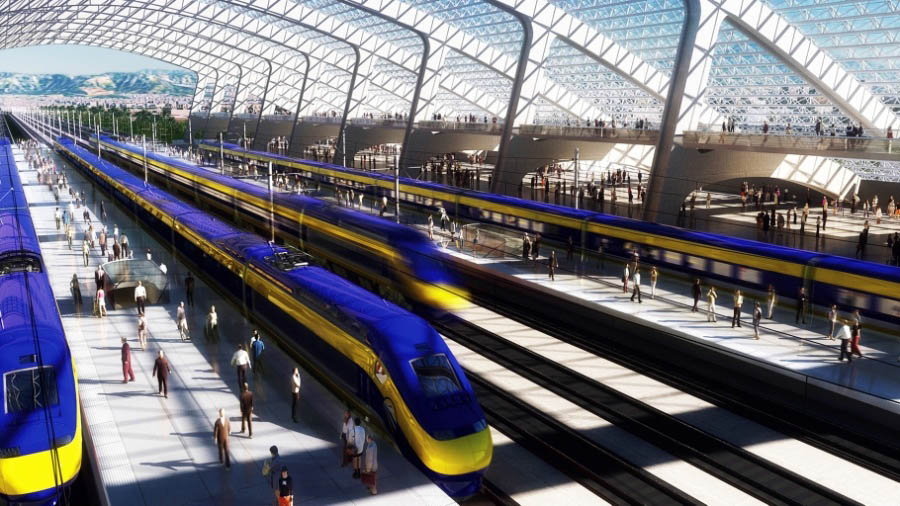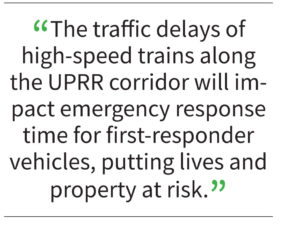The California High-Speed Rail project will change the quality of life for our communities — and there’s no guarantee it will be for the better

Courtesy California High-Speed Rail
Gilroy Station concept illustration
Like many of our fellow South Valley residents, we are deeply concerned about how the California High-Speed Rail, if ever built, will impact the quality of life of our communities. There seems to be too many unknown factors in the project then-Gov. Jerry Brown presented Californians more than a decade ago and which voters approved based on promises of its proposed costs and construction plans.
Among the most worrisome elements of the project are the uncertainty of obtaining enough funding from private and federal government sources, especially if a recession looms ahead of us. Another big question mark hangs over where the alignment of the track will pass through Morgan Hill, San Martin and Gilroy. The legalities — and lawsuits — of obtaining private property through eminent domain and upending long-established neighborhoods is a cause for concern. And in an age of terrorist attacks, the project’s safety needs — such as installing security fencing along the lines — must be factored into the cost of construction.
 Christina Turner, the city manager for Morgan Hill, provided a letter dated Aug. 21 to Boris Limpkin, the regional director for Northern California for the California High Speed Rail Authority. The city has requested the authority consider using the U.S. 101 right-of-way for the placement of the rail line. The CHSRA staff instead identified the preferred route for trains as the “Alternative 4” option. This uses a “blended configuration” between San Jose and Gilroy in the existing Union Pacific Railroad corridor as it passes through South Valley.
Christina Turner, the city manager for Morgan Hill, provided a letter dated Aug. 21 to Boris Limpkin, the regional director for Northern California for the California High Speed Rail Authority. The city has requested the authority consider using the U.S. 101 right-of-way for the placement of the rail line. The CHSRA staff instead identified the preferred route for trains as the “Alternative 4” option. This uses a “blended configuration” between San Jose and Gilroy in the existing Union Pacific Railroad corridor as it passes through South Valley.
It proposes to share the right-of-way with Caltrain commuter and the Union Pacific freight trains. It also assumes the electrification of the tracks, a reconstruction of downtown Morgan Hill’s Caltrain station to add an additional platform, and the elimination of the at-grade pedestrian crossing. From Gilroy, the high-speed rail tracks will continue to a dedicated alignment through Pacheco Pass to connect to the Central Valley lines that will take trains to Los Angeles and elsewhere through the state.
Like Turner, we express our concern about Alternative 4’s impact on Morgan Hill, San Martin and Gilroy. With a maximum capacity of 16 trains per hour during peak hours (going north and south) and with no grade separation, that will impact traffic flow along major east-west corridors such as Dunne, Tennant, Main, and Cochrane avenues. The traffic delays of high-speed trains along the UPRR corridor will impact emergency response time for first-responder vehicles, putting lives and property at risk.
 Impact on Caltrain service is another cause for concern with the Alternative 4 route. The southern section of Santa Clara County will require increasing public transit. U.S. 101 is increasingly congested during the morning and evening commute hours, and Monterey Road and Hale Avenue are taking up the burden. More workers heading to Silicon Valley jobs to the north will find Caltrain a viable transportation option. Turner asked the authority in its draft environmental review to consider additional Caltrain service proposed in the 2040 Caltrain Business Plan.
Impact on Caltrain service is another cause for concern with the Alternative 4 route. The southern section of Santa Clara County will require increasing public transit. U.S. 101 is increasingly congested during the morning and evening commute hours, and Monterey Road and Hale Avenue are taking up the burden. More workers heading to Silicon Valley jobs to the north will find Caltrain a viable transportation option. Turner asked the authority in its draft environmental review to consider additional Caltrain service proposed in the 2040 Caltrain Business Plan.
On Sept. 17 in San Jose, the CHSRA board of directors will hear from staff the recommendations and public feedback during the outreach on which alternative routes to identify as the preferred routes. The draft environmental documents are due to come out in December for the San Jose to Merced project. Final route decisions will be made as the environmental review process concludes in 2020.
Whether the Alternative 4 route succeeds depends on if Union Pacific agrees to give the high-speed rail use of its right of way. In a 2010 letter, the railroad company warned the rail authority it would not agree to allow the high-speed rail system to use any part of its right of way or to be so close to its tracks that it would impair safety or its freight movements. It is not clear if Union Pacific will go along with this option. No doubt, if an agreement is made, there will be considerable costs involved that need to be factored.
Under the Proposition 1a bond act, which voters approved in November 2008, the authority is legally required to design its system to have trains travel from Los Angeles to San Francisco in 2 hours and 40 minutes. Rail experts believe it is improbable the rail would ever meet that trip time in actual operations. Slowing trains through communities from 220 miles an hour to 110 miles an hour will lengthen the trip time.
Adding to the uncertainty of high-speed rail’s success is the fact that its cost, speed through communities, ridership and fares are intertwined in a project facing mounting political and financial challenges. Plus there’s also the question of aesthetics and visual quality of high-speed tracks coming through the South Valley community, noise issues, and the impact on farmland and displacement of homes.
So far, the promise Jerry Brown gave Californians more than a decade ago that high-speed rail was the golden road to the future of transportation has not born out in our confidence for the reality of its success.
We encourage our elected leaders to stay watchful on this project that no doubt will change the quality of life for many people in our communities — and there’s no guarantee it will be for the better.






